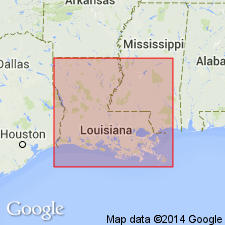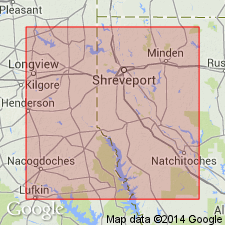
- Usage in publication:
-
- Grand Bayou Member
- Modifications:
-
- Overview
- AAPG geologic province:
-
- Arkla basin
Summary:
Pg. 13. Grand Bayou member of Hall Summit formation. Named in a stratigraphic summary of Louisiana lignite district. Name credited to G. Murray, Jr. Age is Paleocene.
Source: US geologic names lexicon (USGS Bull. 1200, p. 1562).

- Usage in publication:
-
- Grand Bayou member
- Modifications:
-
- Principal reference
- Dominant lithology:
-
- Shale
- AAPG geologic province:
-
- Arkla basin
- East Texas basin
Summary:
Pg. 48 (fig. 2), 59; G.E. Murray, 1948, Louisiana Dept. Conserv. Geol. Bull., no. 25, p. 130-131, pl. 10. Grand Bayou member of Hall Summit formation. Typical carbonaceous shale. Maximum thickness 80 feet on south flank of Sabine uplift. In northeastern part of uplift, believed to thin and marge with overlying Bistineau member; overlies Loggy Bayou member. Age is Paleocene. Type locality designated. Mapped in Texas.
Type locality: exposures in secs. 19, 20, 29, and 30, T. 14 N., R. 9 W., Red River Parish, northwestern LA. Outcrop extends into Shelby Co., TX.
Source: US geologic names lexicon (USGS Bull. 1200, p. 1562).
For more information, please contact Nancy Stamm, Geologic Names Committee Secretary.
Asterisk (*) indicates published by U.S. Geological Survey authors.
"No current usage" (†) implies that a name has been abandoned or has fallen into disuse. Former usage and, if known, replacement name given in parentheses ( ).
Slash (/) indicates name conflicts with nomenclatural guidelines (CSN, 1933; ACSN, 1961, 1970; NACSN, 1983, 2005, 2021). May be explained within brackets ([ ]).

